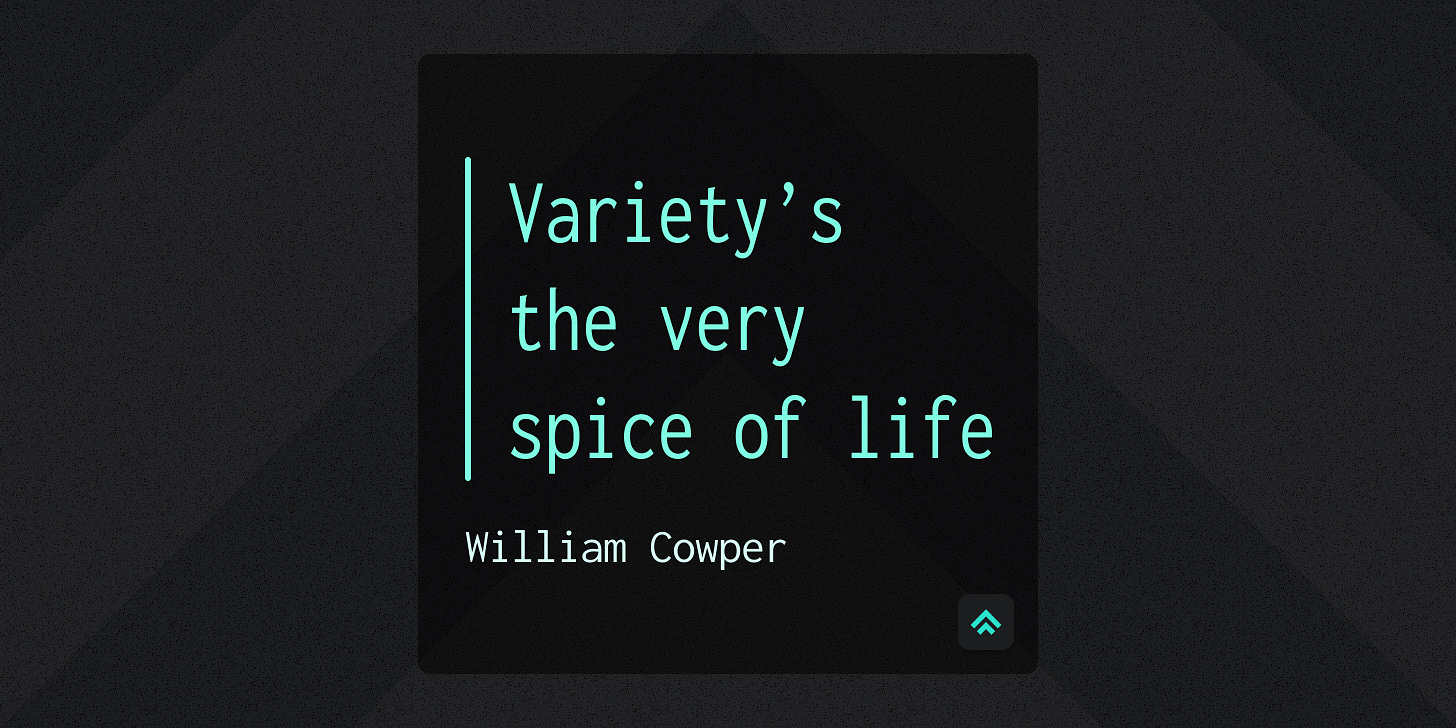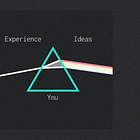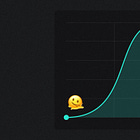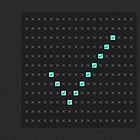Variety: the spice of life or a creative distraction?
Harnessing the power of variety in creative work without losing focus
Introduction
I moved back to Los Angeles last Monday.
You can find everything here.
People from all over the world. Beaches, mountains, and deserts. Skyscrapers and bungalows. Tacos, roti, sushi, barbecue. Lavish wealth and devastating poverty.
It’s all here if you know where to look.
All the stimulation made me think of the proverbial saying from 18th-century English poet William Cowper: “Variety's the very spice of life, That gives it all its flavor”.
Do I feel like this statement is true? Partially.
But Cowper himself used it sarcastically to critique the fashions of his time, so we shouldn’t take it at face value; it contains duality.
While variety can inspire and energize creative work, it can easily become a distraction and obstacle if not managed wisely.
The light side of variety
Good variety energizes and motivates us.
It serves as a vital catalyst for the creative process. By immersing ourselves in a diverse array of experiences, ideas, and perspectives, we open ourselves to a wellspring of inspiration. This variety can fuel our capacity to think outside the box, encouraging novel ideation and innovative problem-solving. It also nurtures our personal growth, broadening our frame of reference and enriching our understanding of the world.
For an example of good variety in action, look no further than the Renaissance Man himself, Mr. Leonardo da Vinci. His voracious appetite for variety resulted in remarkable creativity and his diverse pursuits allowed him to cross-pollinate ideas between fields, leading to groundbreaking contributions in art and science.
In our own creative journeys, embracing variety can likewise ignite fresh ideas, keeping our work dynamic and evolving.
The dark side of variety
Bad variety drains and wears us down.
When we spread our attention too thin, we get overwhelmed and lose sight of what matters. We may start numerous projects, inspired by the novelty each one offers, only to leave them unfinished as our attention jumps to the next exciting idea.
When this happens, we risk letting novelty overshadow substance.
As I mentioned above, Cowper wrote his classic phrase ironically. He critiqued his society’s obsession with constantly changing trends, which he argued added more misery than richness to life. Two hundred years later and it’s easier than ever to get caught up in the pursuit of newness and neglect depth and quality in our work (I wonder what Cowper would have to say about TikTok!? 😳).
This constant quest for variety at the expense of depth hinders our ability to achieve mastery and create our best work. It’s variety as an excuse and a distraction, and must be guarded against at all costs!
Balancing variety for optimal creativity
So, how can we walk the tightrope between leveraging the energizing power of variety and avoiding its potential to distract? Thankfully, the principles of design thinking and intentionality can provide some guidance here. Here are six techniques that consistently help me get the most out of the variety I bring into my life.
1. Intentional learning
Embrace variety in your learning. This might mean reading broadly, trying your hand at a new skill, or subscribing to a cool YouTube channel or newsletter (but, like, who even reads newsletters anyway? 😜). Ask yourself how this new knowledge or skill might enrich your creative work. Don’t just drink from the firehose…
2. Mindful consumption
Be intentional about what you consume. This includes news, social media, books, etc. There’s more new content uploaded to the internet every day than you could ever possibly take in. Being selective and mindful can help ensure that the variety in your media diet is enriching rather than overwhelming.
3. Clarifying desired outcomes
The clearer you are about what you want to achieve in your creative work, the more likely you’ll stumble upon something that delivers. If a new idea or project doesn't align with your current goal, it’s probably a distraction for now. Set it aside. That clarity helps you filter the variety that can be useful to you now from what might be useful to you someday or not at all.
4. Structured experimentation
Set aside specific times for exploration and experimentation. This might be a designated part of your day, week, or project timeline where you actively seek out and engage with sources of inspiration. I love the concept of the “Artist’s Date” from Julia Cameron’s The Artist’s Way program as a practice for giving your exploration some routine structure.
5. Deep work
Make space for periods of focused, uninterrupted work. This is when you put the "spice" of variety to use. Get fully immersed in the task at hand. This might require turning off notifications, creating a quiet workspace, setting timers, etc... Whatever it takes for you to “get in the zone” and produce!
6. Reflection and review
Regularly take time to reflect on your work and your creative process. Consider what's working well and what isn't. Daily journals are a great tool here, but the cadence doesn’t have to be so frequent. Weekly, biweekly, monthly, quarterly, they could all work depending on the context. Just look for where variety is providing inspiration or causing distraction, and adjust accordingly.
Conclusion
In the end, my feelings on the ‘spice’ of variety are another riff on the Goldilocks principle: “Not too much, not too little, just right”. If we add too little variety, our work may lack the zest that captures interest and sparks innovation. But if we add too much, we risk losing the essence of our work amidst a jumble of flavors.
By adopting a mindful and intentional approach to variety — one that values focused depth as much as broad exploration — we can leverage it as a powerful tool in our creative arsenal. We can ensure that our work remains dynamic and fresh, while also maintaining a clear focus that allows us to delve deep and produce meaningful, high-quality output.
So, let's celebrate variety as the spice of life, but also remember to savor each flavor fully and let it enrich our work, rather than overpower it.
If you got a little value from this post, consider subscribing, sharing, or following me on Twitter. If you got a lot of value, consider pledging to support my work with a paid subscription in the future.








As a multi-passionate person, I struggle with exactly what you discuss here: the delicate balance between mastery/depth and variety.
Recently, I had an epiphany of sorts: I needed to better solve for the “switching costs” involved when skipping back and forth between creative pursuits.
As an example, I drew up a quick checklist to reference when picking up my film camera for the first time in awhile: what’s the best YouTube link that reminds me how to load film? And how should I meter one type of film versus another?
Creating a quick resource for each medium means I spend less time relearning the technical basics of a pursuit I haven’t practiced recently, and can quickly get back into the work of actually creating stuff.